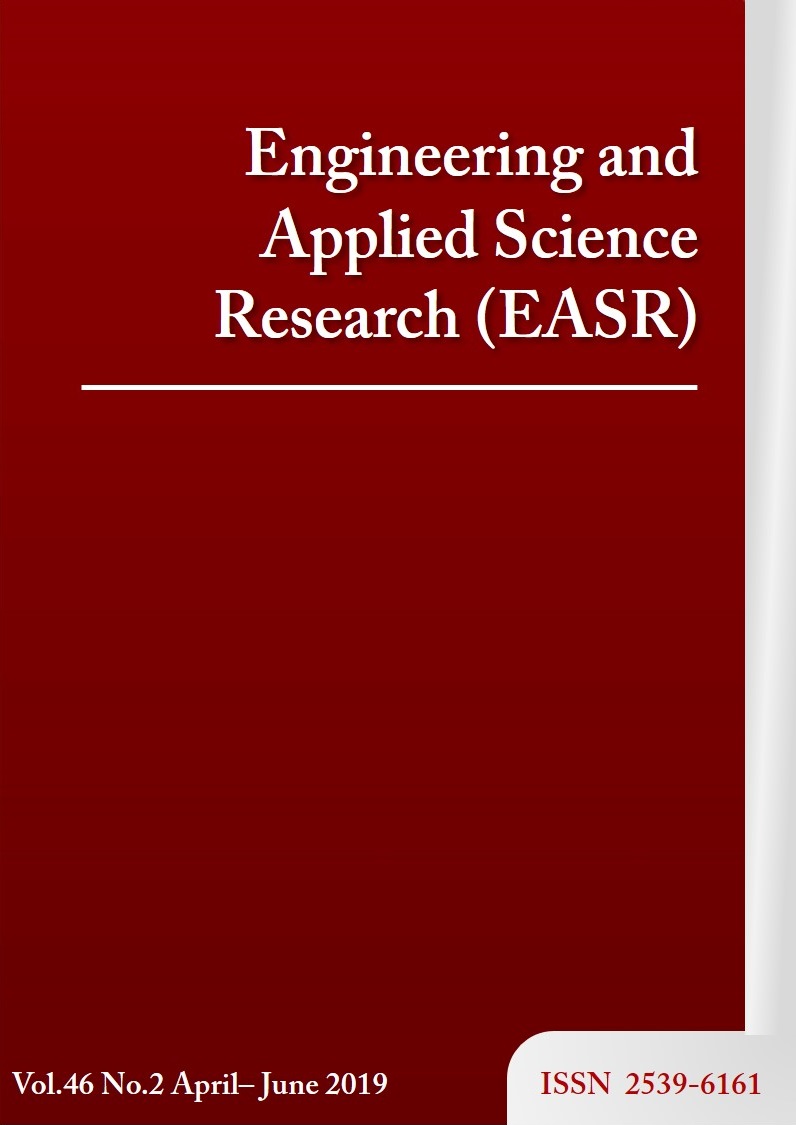Influence of torrefaction temperature and time on the yields and properties of torrefied biomass
Main Article Content
Abstract
Thailand has great potential to use biomass from agricultural wastes for renewable fuels and energy. However, its current utilization is rather low due largely to the high moisture content and low energetic density of these materials. A simple thermal pretreatment such as torrefaction may be useful in adding value to these solid agricultural wastes. The objective of this work was to investigate effect of torrefaction temperature and time on the yields and physico-chemical properties of agricultural wastes (wood chips and oil palm fronds). The torrefaction experimental work was carried out in a laboratory reactor with varying temperatures of 200 to 400 °C and reaction times of 20 to 60 min. A 5 kW electrical heater was used to heat the reactor. From the results obtained, it was found that torrefaction temperature and time affected the solid product proximate and energy properties. The higher heating value of torrefied fuel was increased with torrefaction temperature and time. Optimum torrefaction temperature for wood chips and oil palm fronds was identified at 200 °C, while optimum times were 20 and 40 min, respectively, for maximum mass and energy yields. At these conditions, the energy content of both biomass materials was improved to 17.65 MJ/kg and 16.34 MJ/kg, 20-30% higher than the original values. The value and energy yield of wood chips and oil palm fronds could be improved through torrefaction.
Article Details
This work is licensed under a Creative Commons Attribution-NonCommercial-NoDerivatives 4.0 International License.
References
[2] Cheewaphongphan P, Junpen A, Kamnoet O, Garivait S. Study on the potential of rice straws as a supplementary fuel in very small power plants in Thailand. Energies. 2018;270(11):1-21.
[3] Vadakan NV, Vajanapoom N. Health impact from air pollution in Thailand: current and future challenges. Environ Health Perspect. 2011;119(5):197-8.
[4] IEA Bioenergy.org. Status overview of torrefaction technologies. Paris: International Energy Agency Bioenergy [updated 2015; cited 2018 Dec 12]. Available from: https://www.ieabioenergy.com/.
[5] Li MF, Chen CZ, Li X, Shen Y, Bian J, Sun RC. Torrefaction of bamboo under nitrogen atmosphere: Influence of temperature and time on the structure and properties of the solid product. Fuel. 2015;161:193-6.
[6] Huang YF, Chen WR, Chiueh PT, Kuan WH, Lo SL. Microwave torrefaction of rice straw and pennisetum. Bioresource Technol. 2012;123:1-7.
[7] Chen Y, Yang H, Yang Q, Hao H, Zhu B, Chen H. Torrefaction of agriculture straws and its application on biomass pyrolysis poly-generation. Bioresource Technol. 2014;156:70-7.
[8] Happonen K. Torrefied wood pellets as an alternative fuel to coal: Climate benefits and social desirability of production [dissertation]. Finland: University of Helsinki; 2012.
[9] Parikh J, Channiwala SA, Ghosal GK. A correlation for calculating HHV from proximate analysis of solid fuels. Fuel. 2005;84(5):487-94.
[10] Poudel J, Ohm T, Oh SC. A study on torrefaction of food waste. Fuel. 2015;140:275-81.
[11] Uemura Y, Matsumoto R, Saadon S, Matsumura Y. A study on torrefaction of Laminaria japonica. Fuel Process Tech. 2015;138:133-8.
[12] Chen D, Zhou J, Zhang Q, Zhu X, Lu Q. Upgrading of rice husk by torrefaction and its influence on the fuel properties. Biosources. 2014;9(4):5893-905.
[13] Chen D, Gao A, Cen K, Zhang J, Cao X, Ma Z. Investigation of biomass torrefaction based on three major components: hemicellulose, cellulose, and lignin. Energ Convers Manag. 2018;169:228-37.
[14] Tumuluru JS. Comparison of chemical composition and energy property of torrefied switchgrass and corn stover. Front Energy Res. 2015;3:1-11.
[15] Tumuluru JS, Sokhansanj S, Hess JR, Wrightand CT, Boardman RD. A review on biomass torrefaction process and product properties for energy applications. Ind Biotechnol. 2011;7(5):384-401.
[16] Wilk M, Magdziarz A. Hydrothermal carbonization, torrefaction and slow pyrolysis of Miscanthus giganteus. Energy. 2017;140:1292-304.
[17] Parikh J, Channiwala SA, Ghosal GK. A correlation for calculating HHV from proximate analysis of solid fuels. Fuel. 2005;84(5):487-94.
[18] Zhao X, Song Z, Liu H, Li Z, Li L, Ma C. Microwave pyrolysis of corn stalk bale: A promising method for direct utilization of large-sized biomass and syngas production. J Anal Appl Pyrol. 2010;89(1):87-94.
[19] Chen Y, Yang H, Yang Q, Hao H, Zhu B, Chen H. Torrefaction of agriculture straws and its application on biomass pyrolysis poly-generation. Bioresource Technol. 2014;156:70-7.
[20] Chiou B, Medina DV, Sainz CB, Klamczynski AK, Avena-Bustillos RJ, Milczarek RR, et al. Torrefaction of pomaces and nut shells. Bioresource Technol. 2015;177:58-65.



